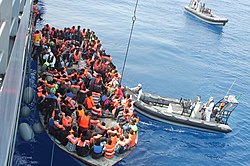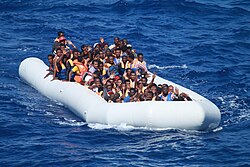
The European Union migration crisis is a migration crisis that began in the early 2010s and peaked in the mid-2010s. It impacted widely all across the European Union (EU), although some southern member states such as Greece and Italy were particularly impacted. The immediate causes of if were refugee crises in the Middle East and the Maghreb, principally the Syrian Civil War, but also the Libyan Civil War and the ongoing instability in Afghanistan and Iraq in the aftermath of the War on Terror waged by the United States from 2001 onwards. The peak of the crisis was in 2015 when 1.3 million people sought refugee status in the EU, though this still paled in comparison with the number of refugees taken in by Turkey and other countries in the Middle East. The migration crisis is seen by some observers as having abated in the years that followed, though it could also be argued that it never ended and has surged upwards again following the Covid-19 pandemic, with Ukrainian refugees and refugees from the Sahel region of Africa replacing Syrians, Libyans and Afghans as the primary types of refugee.[1]
Research your ancestors on MyHeritage
European Union migration crisis chronology of eventsEuropean Union migration crisis chronology of events
There have always been migration and refugee flows within the European Union and its previous iterations such as the European Economic Community. For instance, in the 1990s most EU countries were involved in taking in refugees from a wide range of conflict-riven countries and regions such as Bosnia, Kosovo and Somalia. Through these episodes rules evolved over the decades whereby a certain number of those seeking asylum would receive it and they would be hosted in different member state countries according to size and economic ability.[2]
What made the migration crisis of the mid-2010s so unusual for the EU was the unplanned manner of it. Typically speaking, in times gone by the leaders of the EU were able to negotiate with the United Nations and other organizations to take in refugees in an orderly manner from third countries. For instance, many Kosovans who arrived to EU member states in 1999 and 2000 following the Kosovo War were arriving from Albania, to which country they had fled over the border from Kosovo. The number that would come to a country like Germany was negotiated beforehand and resources were appropriately allocated. In the mid-2010s, none of this happened. Millions of people simply showed up on the southern edges of the European Union and tried to enter it. It was a sign of how desperate the situations they were fleeing from were.[3]

There were many different sources of the migration crisis of the mid-2010s. Unquestionably the biggest push factor was the Syrian Civil War. This had begun in 2011 as part of the wider Arab Spring that rocked the Middle East and the Maghreb that year.[4] Numerous different factions were involved in efforts to unseat President Bashar al-Assad, but clearly the most dreadful was the Islamic State in Syria and Iraq, an utterly extremist Islamic group that took over large sections of Syria and northern Iraq in 2014 and 2015. Here a draconian version of Sharia Law was imposed. The rise of ISIS, combined with the destruction of most of the major cities and towns of Syria, led to one of the largest refugee crises in modern history. Many people started migrating westwards into Turkey. Some tried to go further still to Greece and the EU. They were joined by other waves of refugees from countries like Libya, Iraq and Afghanistan that were suffering their own forms of internal instability.[5]
All of this culminated in a huge spike in migration and asylum applications within the EU. From less than 200,000 applications per year around 2009 and 2010, applications steadily moved upwards from 2011 onwards, reaching quarter of a million in 2012, over 330,000 in 2013, half a million in 2014 and then over 1.2 million in 2015. The number was only marginally lower in 2016. However, thereafter, as deals between the EU and Turkey and other third-party countries to stem migration flows before they ever reached Europe began to take effect, the number fell to an average of half a million per year.[6] Much of this migration flow has not been orderly, with influxes of people on boats in the Mediterranean, usually arriving in Greece, Italy, Malta and Spain. Images of people drowning in the Mediterranean and Aegean Seas during 2015 and 2016 elicited wide-ranging international media coverage of the migration crisis.[7]

While some observers claim that the migration crisis dissipated from 2017 onwards, and came to an end as the Syrian Civil War entered a less violent phase at the end of the 2010s, there is a counter-argument that the migration crisis is still ongoing. There were over 600,000 asylum applications in the EU in 2019, half the figure of the peak year in 2015. A lull followed owing to the Covid-19 Pandemic in 2020 and 2021, but new developments in 2022 and 2023 have seen a renewed upward surge.[8] The specific factors here have been the Russian invasion of Ukraine[9] in February 2022 and also major disturbances in the Sahel region of Africa in countries like Mali and Burkina Faso.[10] In the latter areas people are fleeing civil wars and extremist regimes, as well as the deleterious effects of climate change. As of 2023, the EU is experiencing migration levels which closely mirror those seen in 2015 at the height of the earlier migration crisis peak.
Extent of migration during the European Union migration crisisExtent of migration during the European Union migration crisis
The level of migration involved in the migration crisis is hard to assess. It was not planned and in a huge number of cases involved people being smuggled to Europe’s borders by illegal people smugglers. While many migrants were recorded eventually, others have simply melted into the population. Furthermore, the level of migrants cannot be extrapolated directly from the number of asylum applications, particularly so when it comes to the more recent Ukrainian refugee crisis, during which Ukrainians have been granted different legal statuses to the refugees who were arriving to Europe’s borders from Syria, Libya and the like between 2014 and 2017. Still, the number is very substantial indeed, no matter how one evaluates it. Consider that there have been more than 8.5 million first-time asylum applications within EU countries between 2012 and 2023.[11] This is a larger number than the population of half of the EU member states and cumulatively is nearly equal to the populations of Malta, Luxembourg, Estonia, Latvia, Slovenia and Lithuania combined. Add on the millions of refugees and migrants who are not classed as first-time asylum applicants and one begins to see the scale of the migration crisis which Europe has been confronted with since the Arab Spring began back in 2011.
Demographic impact of the European Union migration crisisDemographic impact of the European Union migration crisis

The demographic impact of the migration crisis had been felt all over the European Union, but it has been experienced most intensely in a number of different countries. Germany’s chancellor at the height of the crisis in the mid-2010s, Angela Merkel, decided that her country would try to lead by example and agreed to take in upwards of a million Syrian refugees. Once the children of those Syrians that were born in Germany is taken into account, we reach a figure of over 1.2 million Syrian Germans. Hence a group which barely existed in German society prior to the mid-2010s, today constitute nearly 1.5% of that country's large population.[12]
Similar trends are in evidence elsewhere, though not as severely in most cases, while some countries like Hungary have attempted to keep their refugee commitments as low as possible. Countries which have tried to follow Germany’s lead and taken in a large number of migrants relative to their population size include Sweden, the Netherlands, Austria, Denmark, Ireland and Belgium. Inevitably when it comes to the coalface of migrant arrivals, Greece, Malta, Italy and Spain, as the nearest countries in the Mediterranean to North Africa have seen the largest influx of migrants arriving on illegal smuggler ships.
See alsoSee also
Explore more about the European Union migration crisisExplore more about the European Union migration crisis
- 2015: The Year of Europe's Refugee Crisis at UN Refugee Agency
- Germany's Never-Ending Migration Crisis at Politico.eu
- Migrant Crisis: Migration to Europe Explained in Seven Charts at BBC News
References
- ↑ https://www.bbc.co.uk/news/world-europe-53925209
- ↑ https://www.pewresearch.org/global-migration-and-demography/2016/08/02/number-of-refugees-to-europe-surges-to-record-1-3-million-in-2015/
- ↑ https://www.cfr.org/backgrounder/europes-migration-crisis
- ↑ https://www.cfr.org/backgrounder/europes-migration-crisis
- ↑ https://www.cfr.org/global-conflict-tracker/conflict/conflict-syria
- ↑ https://ec.europa.eu/eurostat/statistics-explained/index.php?title=Asylum_statistics&oldid=558844
- ↑ https://www.unhcr.org/uk/news/stories/2015-year-europes-refugee-crisis
- ↑ https://ec.europa.eu/eurostat/statistics-explained/index.php?title=Asylum_statistics&oldid=558844
- ↑ https://www.unrefugees.org/emergencies/ukraine/
- ↑ https://www.lemonde.fr/en/international/article/2024/01/10/europe-faced-migration-resurgence-from-africa-in-2023_6420639_4.html
- ↑ https://ec.europa.eu/eurostat/statistics-explained/index.php?title=Asylum_statistics&oldid=558844
- ↑ https://www.ncbi.nlm.nih.gov/pmc/articles/PMC10210136/

